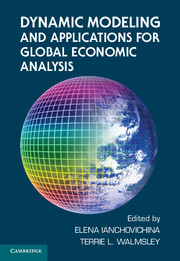Book contents
- Frontmatter
- Contents
- Contributors
- Acknowledgments
- PART I INTRODUCTION AND OVERVIEW
- PART II STRUCTURE OF THE DYNAMIC GTAP FRAMEWORK
- PART III APPLICATIONS OF DYNAMIC GTAP
- 8 Assessing the Impact of China's WTO Accession on Investment
- 9 Dynamic Effects of the “New-Age” Free Trade Agreement between Japan and Singapore
- 10 Resource Use and Technological Progress in Agriculture
- 11 Global Economic Integration and Land-Use Change
- 12 The Contribution of Productivity Linkages to the General Equilibrium Analysis of Free Trade Agreements
- 13 Global Demographic Change, Labor Force Growth, and Economic Performance
- PART IV EVALUATION OF THE DYNAMIC GTAP FRAMEWORK
- Appendix: Negative Investment: Incorporating a Complementarity into the Dynamic GTAP Model
- Glossary of GDyn Notation
- Index
- References
9 - Dynamic Effects of the “New-Age” Free Trade Agreement between Japan and Singapore
Published online by Cambridge University Press: 05 June 2012
- Frontmatter
- Contents
- Contributors
- Acknowledgments
- PART I INTRODUCTION AND OVERVIEW
- PART II STRUCTURE OF THE DYNAMIC GTAP FRAMEWORK
- PART III APPLICATIONS OF DYNAMIC GTAP
- 8 Assessing the Impact of China's WTO Accession on Investment
- 9 Dynamic Effects of the “New-Age” Free Trade Agreement between Japan and Singapore
- 10 Resource Use and Technological Progress in Agriculture
- 11 Global Economic Integration and Land-Use Change
- 12 The Contribution of Productivity Linkages to the General Equilibrium Analysis of Free Trade Agreements
- 13 Global Demographic Change, Labor Force Growth, and Economic Performance
- PART IV EVALUATION OF THE DYNAMIC GTAP FRAMEWORK
- Appendix: Negative Investment: Incorporating a Complementarity into the Dynamic GTAP Model
- Glossary of GDyn Notation
- Index
- References
Summary
Introduction
In the 1990s, there was a flood of regional trade agreements. By 2001, more than 130 such agreements were in place (WTO2000). The European Union, the North America Free Trade Agreement (NAFTA), and MERCOSUR have been particularly effective at promoting intraregional trade. This success has led other countries to explore options for such regional agreements, and in December 1999, Japan and Singapore established a Joint Study Group to examine the feasibility and desirability of establishing an FTA. After a favorable report from the Study Group, negotiations commenced in early 2001 (Joint Study Group 2000a), and the Japan-Singapore FTA came into effect in November 2002.
The main elements of the Japan-Singapore FTA involve bilateral liberalization and facilitation of trade through reduction of tariff and nontariff barriers, as well as the mutual recognition of national standards, streamlining of customs procedures, facilitation of increased services trade, and the establishment of an exemplary framework for foreign investment. This “new-age” FTA also envisioned increased collaboration on intellectual property, education and training, media and broadcasting, and tourism. This trade agreement is particularly significant, because it is viewed by many as providing a possible template for future FTAs in the region, for example the FTA between Japan and Korea (KIEP 2000).
- Type
- Chapter
- Information
- Dynamic Modeling and Applications for Global Economic Analysis , pp. 235 - 268Publisher: Cambridge University PressPrint publication year: 2012
References
- 2
- Cited by

